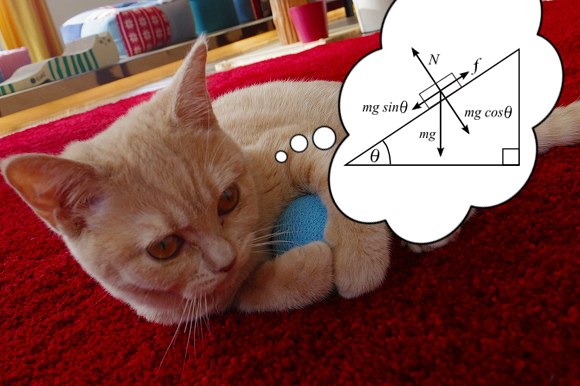
As long as it’s with regards to Newton’s laws of motion and electromagnets, research shows curiosity does not kill the cat after all.
A team at Kyoto University recently ran tests to learn more about cats’ ability to use logical thinking. In this study, researchers examined if a cat would expect to see something based on a sound it heard. Previous attempts had been made with other animals, but the failure rate was high.
As it turned out, other animals, such as primates, were turned off by unknown sounds for fear that it might be a threat. On the other hand, cats have the unique personality trait of interpreting a noise as something they might want to kill and eat and were more intrigued by it.
So the team visited some cat cafes and homes of cat owners with a specially designed steel container and iron object to go inside. The container was also fit with an electromagnet allowing the object to cling to the bottom when needed.
An examiner would then approach an individual feline in an isolated environment and call their name to get their attention. They would then shake the box and turn it upside down so that the object would fall out. While taking breaks in between, they repeated the procedure but used the magnet to create different causes and effects.
The examiners also video recorded the cats’ reactions for detailed analysis and smiled warmly throughout because this whole testing was all so gosh-darned precious.
What they found was the cats were mostly interested in cases 2 and 3 where unexpected results occurred. Interest was measured by the time they spent staring at the container. This means that the cats were possibly applying laws of physics to the apparatus and expecting an object to fall out once they heard a sound and vice versa.
It should be noted that not all cats demonstrated an equal thirst for knowledge. Out of 45 tested cats, 15 were refused because they expressed either fear or indifference at the experiment – knowing cats, the majority of them probably felt the latter.
It certainly seems as though an Ig Noble Prize is in the works for this breakthrough in animal inference research and the team is far from finished. They would also like to test cats’ hearing more in depth to learn whether they can determine how many objects are in a box and whether to expect a certain number to fall out of the container.
Once we are in possession of this knowledge, the human race can finally…hmm, like apply it to other fields of study and stuff. Alright, I don’t know about humanity but I can finally guilt my daughter into doing her science homework by saying even a cat can do it.
Source: Sputnik News (Japanese), Ars Technica (English), Springer Link (English)
Images: RocketNews24
Friction Diagram: Wikipedia/Mets501


 Japanese universities determine cats know the names of other cats
Japanese universities determine cats know the names of other cats Japan now has a traffic safety video for cats to watch to help keep them safe on the streets
Japan now has a traffic safety video for cats to watch to help keep them safe on the streets Japanese team wins Ig Nobel prize for confirming that banana peels are in fact slippery
Japanese team wins Ig Nobel prize for confirming that banana peels are in fact slippery Data shows Fukui Prefecture may be the best place to live in Japan, but survey results differ
Data shows Fukui Prefecture may be the best place to live in Japan, but survey results differ Clever Japanese pet owners find perfect cat beds…at IKEA! 【Photos】
Clever Japanese pet owners find perfect cat beds…at IKEA! 【Photos】 How to order snacks on a Shinkansen bullet train in Japan
How to order snacks on a Shinkansen bullet train in Japan Burger King Japan suddenly adds Dr. Pepper and Dr. Pepper floats to its menu nationwide
Burger King Japan suddenly adds Dr. Pepper and Dr. Pepper floats to its menu nationwide New Nintendo Lego kit is a beautiful piece of moving pixel art of Mario and Yoshi【Photos】
New Nintendo Lego kit is a beautiful piece of moving pixel art of Mario and Yoshi【Photos】 Hello, cosmetics! Clinique teams up with Hello Kitty this summer for first-time collaboration
Hello, cosmetics! Clinique teams up with Hello Kitty this summer for first-time collaboration Demon Slayer: Kimetsu no Yaiba gets new roller coaster attractions and food at Universal Studios Japan
Demon Slayer: Kimetsu no Yaiba gets new roller coaster attractions and food at Universal Studios Japan 11 different ways to say “father” in Japanese
11 different ways to say “father” in Japanese Kyoto tea merchant’s matcha parfait ice cream bars: The desserts we’ve been waiting 187 years for
Kyoto tea merchant’s matcha parfait ice cream bars: The desserts we’ve been waiting 187 years for East meets West in the Pacific-centered version of the world map
East meets West in the Pacific-centered version of the world map What do you eat when you catch a cold? We asked 11 of our Japanese reporters
What do you eat when you catch a cold? We asked 11 of our Japanese reporters Shinjuku izakaya’s all-you-can-eat-and-drink plan is one of Tokyo’s best secret cheap eats
Shinjuku izakaya’s all-you-can-eat-and-drink plan is one of Tokyo’s best secret cheap eats Nintendo history you can feel – Super NES, N64, and GameCube controllers become capsule toys
Nintendo history you can feel – Super NES, N64, and GameCube controllers become capsule toys “The most Delicious Cup Noodle in history” – Japan’s French Cup Noodle wins our heart【Taste test】
“The most Delicious Cup Noodle in history” – Japan’s French Cup Noodle wins our heart【Taste test】 Starbucks releases a cute Frappuccino and Unicorn Cake…but not in Japan
Starbucks releases a cute Frappuccino and Unicorn Cake…but not in Japan Kyoto Tower mascot termination reveals dark side behind cute Japanese characters
Kyoto Tower mascot termination reveals dark side behind cute Japanese characters McDonald’s Japan’s Soft Twist Tower: A phantom ice cream only sold at select branches
McDonald’s Japan’s Soft Twist Tower: A phantom ice cream only sold at select branches Yabai Ramen: What makes this Japanese ramen so dangerous?
Yabai Ramen: What makes this Japanese ramen so dangerous? Finally! Nintendo Japan expands Switch 8-bit controller sales to everybody, Online member or not
Finally! Nintendo Japan expands Switch 8-bit controller sales to everybody, Online member or not Japanese government wants to build luxury resorts in all national parks for foreign tourists
Japanese government wants to build luxury resorts in all national parks for foreign tourists To combat declining birth rate, Japan to begin offering “Breeding Visas” to foreigners
To combat declining birth rate, Japan to begin offering “Breeding Visas” to foreigners 10 things you should buy at 7-Eleven in Japan
10 things you should buy at 7-Eleven in Japan Studio Ghibli releases anime heroine cosplay dresses that are super comfy to wear
Studio Ghibli releases anime heroine cosplay dresses that are super comfy to wear Woman charged for driving suitcase without a license in Osaka
Woman charged for driving suitcase without a license in Osaka Studio Ghibli unveils My Neighbour Totoro miniature house model
Studio Ghibli unveils My Neighbour Totoro miniature house model Kyoto experiencing problems with foreign tourists not paying for bus fares, but not on purpose
Kyoto experiencing problems with foreign tourists not paying for bus fares, but not on purpose Fighting mild hunger with a Japanese soda that turns into jelly in the stomach【Taste test】
Fighting mild hunger with a Japanese soda that turns into jelly in the stomach【Taste test】 Studio Ghibli’s Howl’s Moving Castle tapestry unveiled in Japan for first time
Studio Ghibli’s Howl’s Moving Castle tapestry unveiled in Japan for first time McDonald’s new Happy Meals offer up cute and practical Sanrio lifestyle goods
McDonald’s new Happy Meals offer up cute and practical Sanrio lifestyle goods Sales of Japan’s most convenient train ticket/shopping payment cards suspended indefinitely
Sales of Japan’s most convenient train ticket/shopping payment cards suspended indefinitely Sold-out Studio Ghibli desktop humidifiers are back so Totoro can help you through the dry season
Sold-out Studio Ghibli desktop humidifiers are back so Totoro can help you through the dry season Japanese government to make first change to romanization spelling rules since the 1950s
Japanese government to make first change to romanization spelling rules since the 1950s Foreigner’s request for help in Tokyo makes us sad for the state of society
Foreigner’s request for help in Tokyo makes us sad for the state of society Ghibli founders Toshio Suzuki and Hayao Miyazaki contribute to Japanese whisky Totoro label design
Ghibli founders Toshio Suzuki and Hayao Miyazaki contribute to Japanese whisky Totoro label design Doraemon found buried at sea as scene from 1993 anime becomes real life【Photos】
Doraemon found buried at sea as scene from 1993 anime becomes real life【Photos】 Tokyo’s most famous Starbucks is closed
Tokyo’s most famous Starbucks is closed Princesses, fruits, and blacksmiths: Study reveals the 30 most unusual family names in Japan
Princesses, fruits, and blacksmiths: Study reveals the 30 most unusual family names in Japan Japan’s cat cafes expected to get permanent permission to operate past 8 p.m.
Japan’s cat cafes expected to get permanent permission to operate past 8 p.m. These adorable Japanese stacking cat boxes will keep you company and your living space organized
These adorable Japanese stacking cat boxes will keep you company and your living space organized Yawns can be contagious for cats too, Japanese pet owner’s adorable felines prove【Photo】
Yawns can be contagious for cats too, Japanese pet owner’s adorable felines prove【Photo】 Can these Japanese kitties accurately predict the advancing teams of the World Cup?
Can these Japanese kitties accurately predict the advancing teams of the World Cup? Japan now has diapers specially for cats
Japan now has diapers specially for cats Capcom Japan’s April Fool is awesome, nyansensical
Capcom Japan’s April Fool is awesome, nyansensical Is Japan’s Cat Island in danger of turning into the Island of Fat Cats?
Is Japan’s Cat Island in danger of turning into the Island of Fat Cats? Excessive dog pee to blame for traffic light collapse, Japanese police think
Excessive dog pee to blame for traffic light collapse, Japanese police think Japan to release a Complimenting Card Game through crowdfunding
Japan to release a Complimenting Card Game through crowdfunding Can cats cut the cost of power? Japanese delivery company with a cat-themed name investigates
Can cats cut the cost of power? Japanese delivery company with a cat-themed name investigates Japan has a cat aptitude test to show off how much you know about our feline friends
Japan has a cat aptitude test to show off how much you know about our feline friends Here’s a magic frame that can warp a cat’s butt through your wall
Here’s a magic frame that can warp a cat’s butt through your wall Small children have magnetic “cat-attracting” ability, adorable photos from Japan show
Small children have magnetic “cat-attracting” ability, adorable photos from Japan show Japanese cat book explains how cats see their human owners, and it’s not as objects of respect
Japanese cat book explains how cats see their human owners, and it’s not as objects of respect Cats trapped in circles! Japanese blogger shows the best way to outsmart your kitty【Photos】
Cats trapped in circles! Japanese blogger shows the best way to outsmart your kitty【Photos】
Leave a Reply